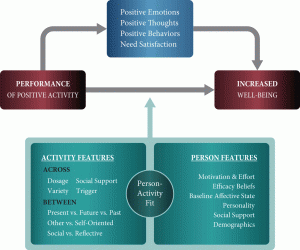
Trying to be happier at Work? Read This First.
Did you know the human brain is perhaps the most complex thing we’ve discovered in the universe so far? Each person reading this article has 85 to 100 billion neurons, and each of those neurons is connected to thousands of other neurons. This means that each brain is unique—every brain you work with is unique. So you can’t take the study results and averages from research and say they are going to work the same way for everyone, all of the time. To express this, at Happy Brain Science, we often say “your mileage will vary.”
In the field of positive psychology, it is referred to as “Person-Activity fit”. Which means, as you apply positive psychology strategies in the workplace, it is important to make sure that what you are doing works well for you and the people you work most closely with.
This is just what researcher Sonja Lyubomirsky talked about in her plenary session at the International Positive Psychology Association’s 5th World Congress. As the diagram on the right shows, there are components about the activity and the person that must be aligned for an activity to bring about the positive emotions, thoughts and behaviors that increase well-being.
In the Congress Session, Sonja shared three primary causes for a person-activity misfit are:
- Frequency: In this article by Lyubomirsky, Sheldon & Schkade, the researches findings suggest “people should strive to discover the optimal timing for each activity, that is, a frequency of engagement that allows that activity to remain fresh, meaningful, and positive for a particular person.”

- Variety: Hedonic adaption is scientific way to express that we get used to what we have an experience each day, and because we get used to what we have and experience even things that make us happy at first have less and less of an impact over time. This is why research suggests it is so important to seek variety in your happiness-boosting behaviors.
- Motivation: In a study conducted in 2011, participants were asked to either write their Best Possible Future or write gratitude letters–in both activities, researchers found that a person’s motivation was critical in the activity increasing their happiness and well-being.
What does this mean for you as you apply brain science and psychology to boost your well-being? That to increase your happiness–and therefore productivity and success–at work, it is suggested by research that you be mindful of the frequency, variety and meaning/motivation you have towards the strategies you apply. If writing a Best Possible Future is stressful to you, perhaps you try doing a random act of kindness.
If you are looking for ideas on what strategies might work best for you, check out these other Happy Brain Science blog posts: